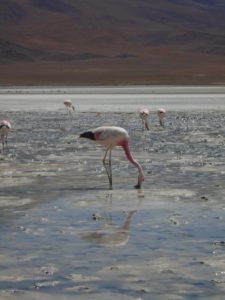Bolivia is gritty, earthy and genuine. In the space of a month, I saw so many landscapes from lush rainforests to clear white salt deserts. When I remember the cholitas in native dress selling on every street corner, the white mountains looming over La Paz, the markets making the best juices from fruits you’ve just discovered, my addiction to fried egg and avocado sandwiches… I want to go back.

I crossed into Bolivia from Chile’s San Pedro de Atacama on a classic three-day tour of the salt flats. The landscape is nature’s craziest, most beautiful invention. A lake so clear, it perfectly reflects the snow-covered mountain rising above desert. Vicuna graze on vast plains of nothing. Pink flamingos feed in a red lake rimmed by yellow under a blue sky. I attempted to climb surreal rock formations said to have inspired Dali, stayed in a hotel entirely made of salt, and tasted coca beer.
I arrived in the town of Uyani and immediately got a bus to Potosi. Potosi is famous for its silver mines which kept the Spanish Empire rich for centuries with one of the worst safety records and highest death rates of any mine. Tours of the mines can be highly dangerous and exploitative… choose wisely. My tour stopped by the markets to pick up some gifts for the miners: coca leaves, cigarettes, pure alcohol and dynamite (about £2.50 a stick). The entrance is a wooden hatch in the ground and then you climb an old ladder before crawling some distance. You can hear explosions in the distance. There are creepy statues to the miners’ deity El Tio leering at you out of the dark; miners pour alcohol and coca leaves over his giant penis in an offering to get out of the mine alive. After two hours, I hurried out of the tunnel to see sunshine again; the miners have to work 12 hour shifts six days a week.
After Potosi, I spent some time in the white city of Sucre. Its is a beautiful, almost colonial town which is very easy to spend a few days relaxing and recovering in. Travelling on to La Paz, I saw both sides of the steep valley to which the city clings. From the main road at the bottom, it feels like walls of houses are rising up above your head. I wandered around the markets considering whether to buy a llama fetus and visited Tiwanaku, an ancient site that a lovely man on the bus told me could only have been built by aliens.
The choices to get to Rurrenabaque, my next destination, were either a 19 hour bus ride including “The World’s Most Dangerous Road” or an equally hair-raising small aircraft flight. I chose the bus which crawled along, scraping at the cliffs one side while the road was invisible beneath the wheels on the other side. I started to imagine a lean gently sideways on the vehicle… or maybe that wasn’t even my imagination. We had to stop for four hours because the road was washed out and everyone had to help rebuild it with some pickaxes. All in all, a very exciting way to start a trip to the Amazon!
In Rurrenabaque, I took a boat to a lodge in the jungle. Because there was an incredible tropical storm the night before, the weather was actually quite cold and not as steamy as expected. We spent the days exploring the green jungle, red cliffs and brown water. We fished for piranhas and fed the camp’s resident baby tapir. We saw spider monkeys, avoided bullet ants, had an extreme jewellery class involving drills, hunted jaguars at night, and learnt that there is such a thing as a garlic tree and a tree that can “walk”. My favourite times were the evenings spent sitting in my hammock watching the hummingbirds feed on pink flowers.
A more palatable bus ride back led me to Copacabana, the main town on the shores of Lake Titicaca. A lot of people were there because it was the Festival de la Cruz. This meant I watched a lot of crazy parades and met some very fun drunk cholitas. Outside the cathedral, Benedicionde de Movilidades was taking place: when the priests bless newly clean cars with flowers, holy water and alcohol. I ended up sleeping in a room in the home of a lovely family because there was not a bed to be had in town.
A final highlight of Bolivia was the Isla del Sol. I spent two very happy days there wandering around to see Inca ruins and attempting to eat as much lake trout as possible. Its setting is incredible: green terraces running down to the blue lake with the snow covered Andes behind, sheep and donkeys everywhere, with not a single road but paved Inca paths. I cannot recommend this place enough- stay at least one night so you get to experience it without the crowds.
TOP TIPS TO LOVE BOLIVIA
- Remember the high altitude of most of the country, including La Paz and the Salt Flats. Bring medication, drink lots of water (or coca tea) and pace yourself when you first arrive
- Pack out what you bring in to remote places such as the Salt Flats, don’t leave rubbish behind
- Check all the services that you use to ensure that as much of your money stays within the local communities and that they have a good safety record
- Buses run frequently, are cheap and can be very comfortable, especially at night when they have almost bed-like reclining seats. Just always bring snacks, water, toilet paper and hand sanitiser
- Try the fried egg and avocado sandwiches available at any bus station- yum!
- Remember to take photos. I evidently forgot to do this